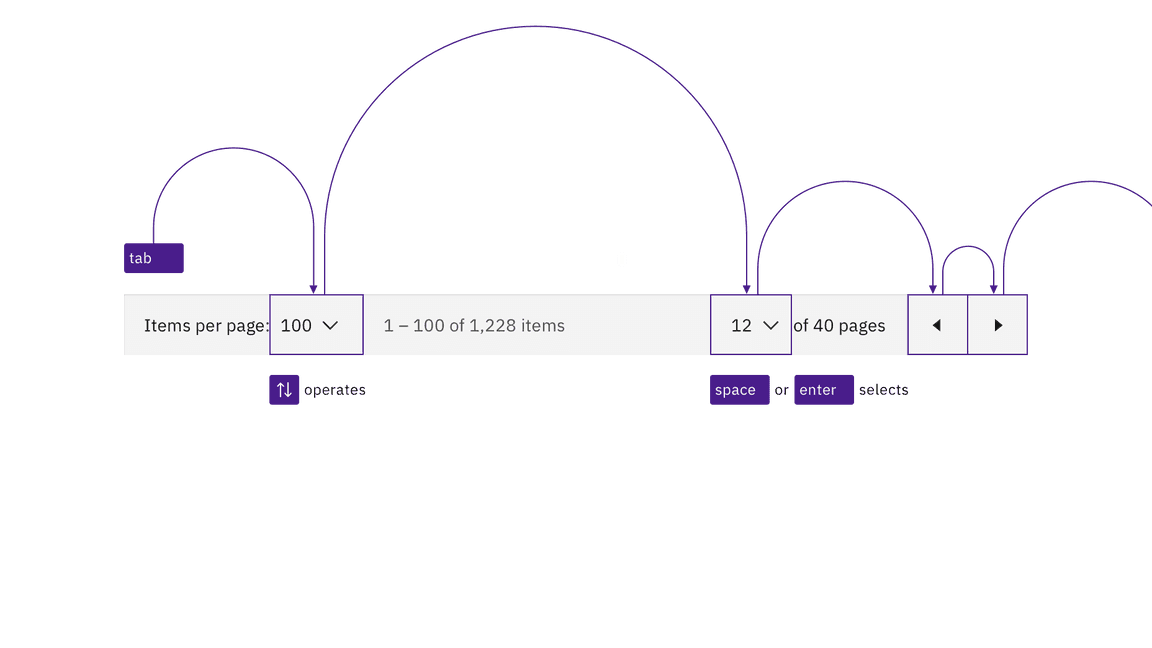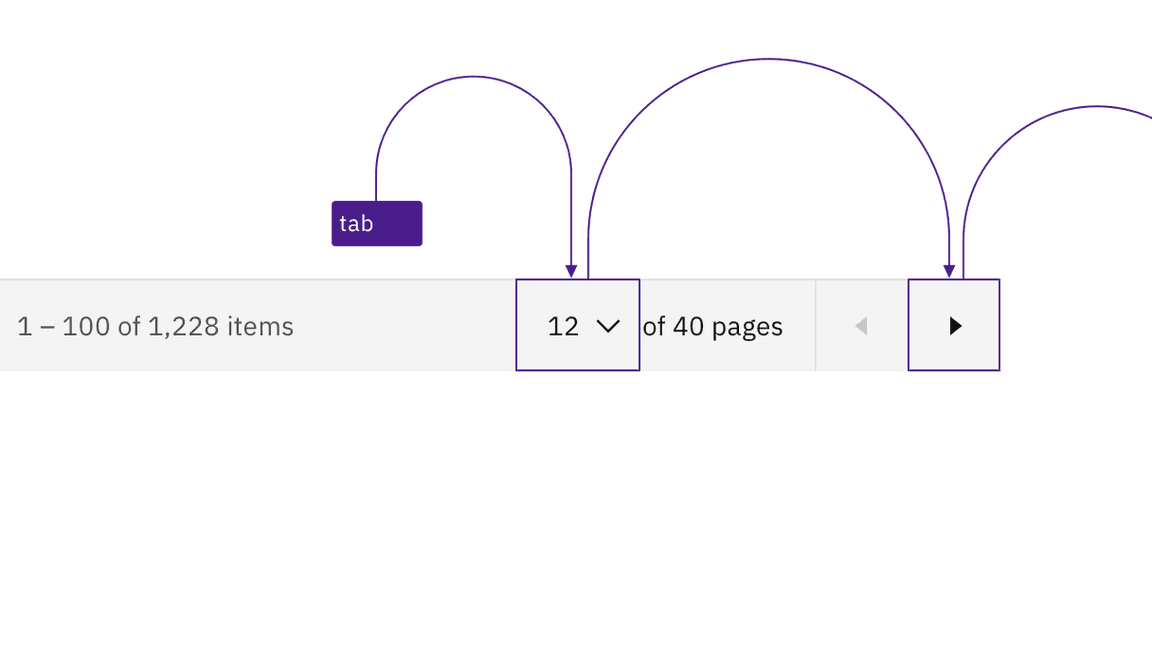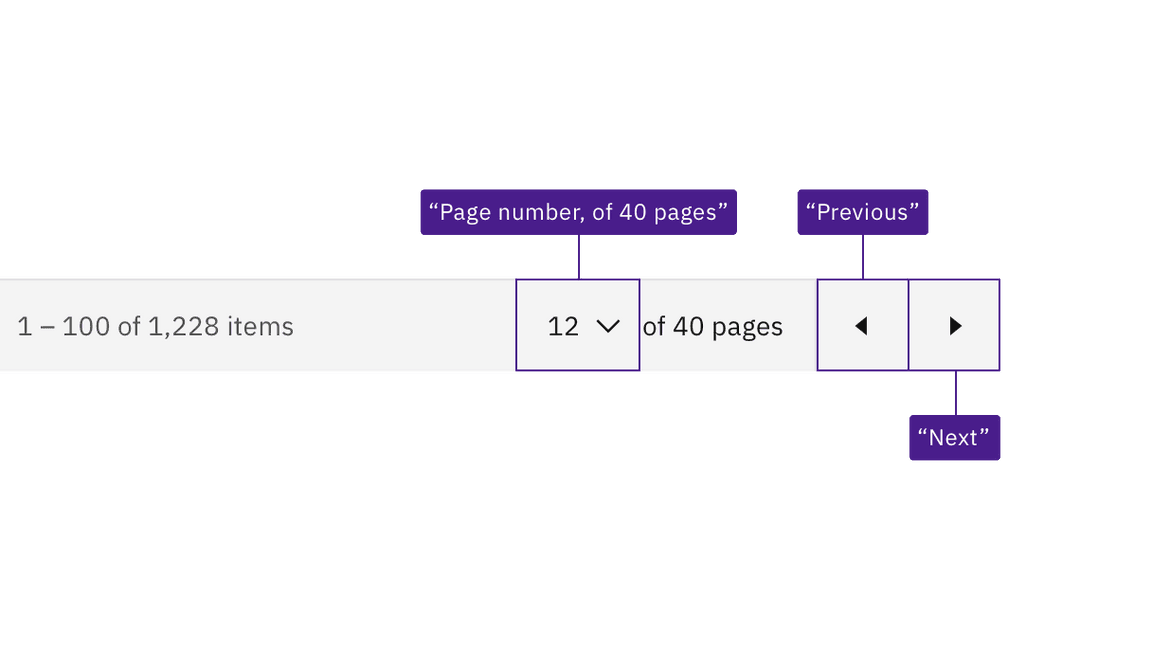Pagination
No accessibility annotations are needed for pagination, but keep these considerations in mind if you are modifying Carbon or creating a custom component.
Accessibility testing statusFor every latest release, Carbon runs tests on all components to meet the accessibility requirements. These different statuses report the work that Carbon has done in the back end. These tests appear only when the components are stable.
For every latest release, Carbon runs tests on all components to meet the accessibility requirements. These different statuses report the work that Carbon has done in the back end. These tests appear only when the components are stable.
Latest version: ^1.51.0 | Framework: React (@carbon/react)
| Component | Accessibility test | Status | Link to source code |
|---|---|---|---|
| Pagination | Test(s) that ensure the initial render state of a component is accessible. | Passes all automated tests with no reported accessibility violations. | GitHub link |
| Tests that ensure additional states of the component are accessible. This could be interactive states of a component or its multiple variants. | Passes all automated tests with no reported accessibility violations. | ||
| Tests that ensure focus is properly managed, and all interactive functions of a component have a proper keyboard-accessible equivalent. | Passes all automated tests with no reported accessibility violations. | ||
| This manual testing ensures that the visual information on the screen is properly conveyed and read correctly by screen readers such as JAWS, VoiceOver, and NVDA. | A human has manually tested this component, e.g. screen reader testing. | ||
| Pagination nav | Test(s) that ensure the initial render state of a component is accessible. | Passes all automated tests with no reported accessibility violations. | GitHub link |
| Tests that ensure additional states of the component are accessible. This could be interactive states of a component or its multiple variants. | Automated or manual testing has been temporarily deferred. | ||
| Tests that ensure focus is properly managed, and all interactive functions of a component have a proper keyboard-accessible equivalent. | Passes all automated tests with no reported accessibility violations. | ||
| This manual testing ensures that the visual information on the screen is properly conveyed and read correctly by screen readers such as JAWS, VoiceOver, and NVDA. | A human has manually tested this component, e.g. screen reader testing. |
What Carbon provides
Carbon bakes keyboard operation into its components, improving the experience of blind users and others who operate via the keyboard. Carbon incorporates many other accessibility considerations, some of which are described below.
Keyboard interaction
The tab order goes from left to right through the controls in the pagination
component. On focus, the dropdowns are opened with Space or with up or down
arrows, which also cycle through the values. Both Space and Enter select a
value and close the dropdown. The dropdown can also be closed by pressing Esc.
The previous and next page arrow buttons are activated by Space or Enter
keys.

Interactive elements in pagination maintain their usual Carbon keyboard behaviors and tab order.
When the pagination is at either end of its range, one of the page navigation buttons becomes invalid. When that happens, the button is no longer navigable or operable, like any other disabled control.

The prior page button is disabled and unreachable when the pagination is at the start of its range.
Labeling
Not all the elements in pagination have static or visually isolated labels. Carbon constructs a programmatic name for the second dropdown by concatenating some dynamically generated text on the screen. Carbon also provides accessible names for the icon-only buttons.

Carbon provides the accessible names "page number, of 40 pages", "previous page", and "next page" for assistive technology.
Development considerations
Keep these considerations in mind if you are modifying Carbon or creating a custom component.
- Carbon uses
<select>elements for the dropdowns. - Consult the ARIA authoring practices for more considerations.